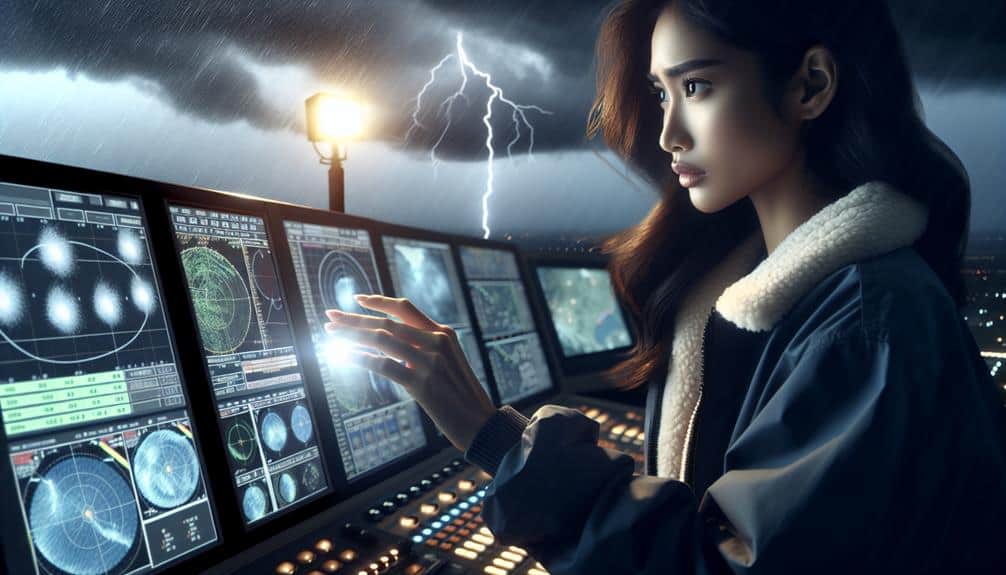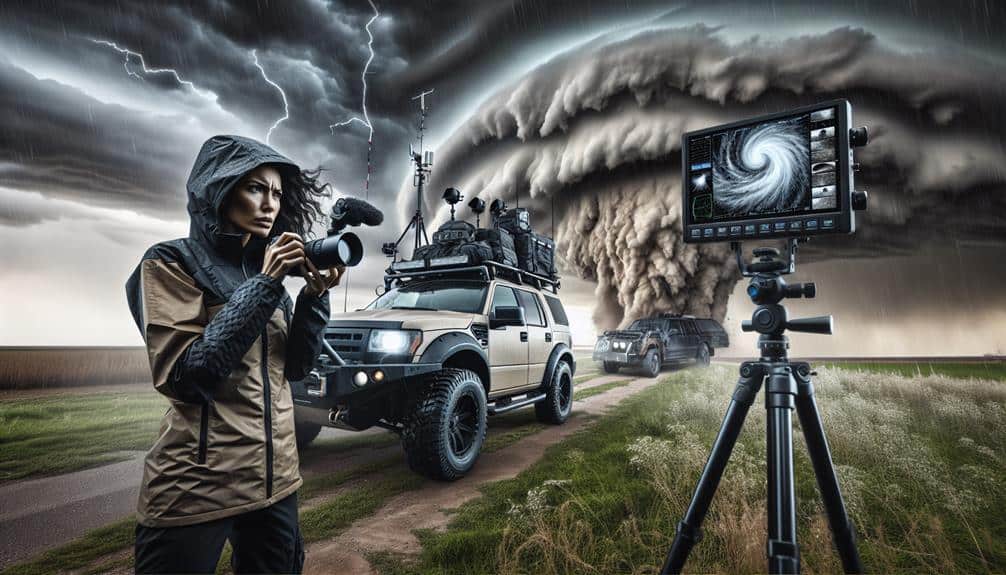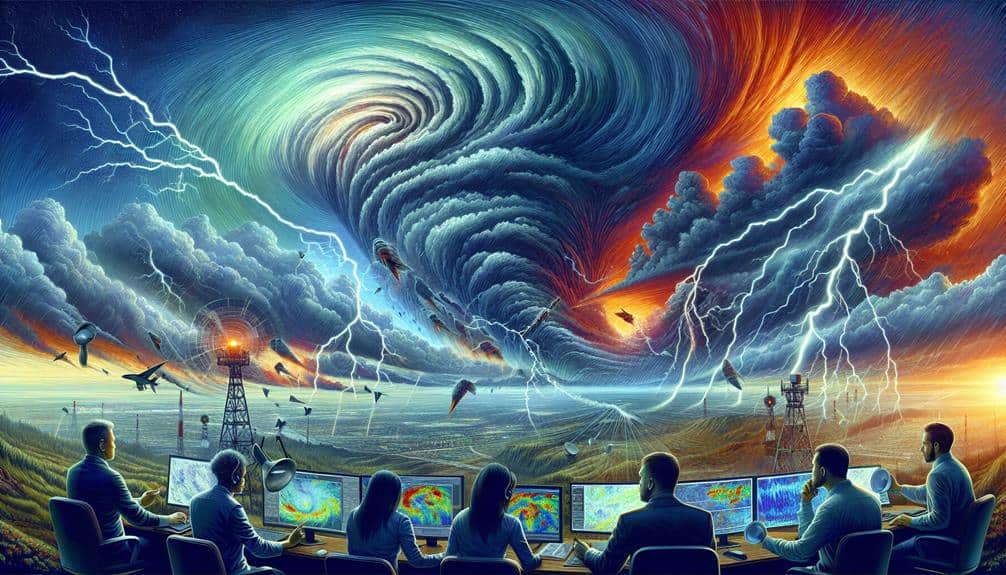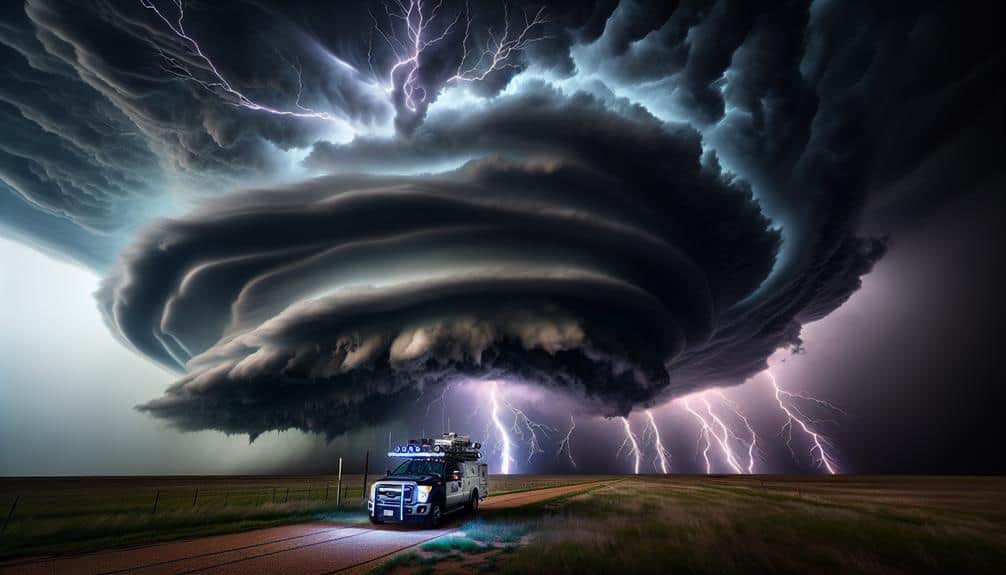When it comes to extreme storm chasing, we can't afford to take chances; our survival hinges on strategic planning and quick thinking. First, safety is paramount—conduct thorough risk assessments and always have a well-rehearsed emergency plan. Gear up with essentials like a first aid kit, sturdy footwear, and enough food and water for 72 hours. Continuously monitor weather updates using reliable radar apps and storm tracking websites. Before heading out, map multiple escape routes and share them with a trusted contact. Finally, stay educated with the latest meteorological data and tips from seasoned chasers. Join us as we explore more detailed strategies.
Key Points
- Prioritize safety by conducting thorough risk assessments and emergency preparedness, ensuring you're mentally and physically ready for any scenario.
- Equip yourself with essential gear, including a first aid kit, sturdy footwear, and enough food and water for 72 hours.
- Continuously monitor reliable weather updates using radar apps, weather stations, and storm tracking websites.
- Plan multiple escape routes considering storm speed, direction, and geography, and share these routes with a trusted contact.
Prioritize Safety First
When chasing extreme storms, we've got to make safety our absolute priority, ensuring that every decision we make minimizes risk. The first step on our adventure is detailed risk assessment. We need to know what we're up against—tornadoes, lightning, hail, or flash floods. We should analyze weather patterns, study storm trajectories, and understand the environment we're venturing into. This thorough planning helps us identify potential hazards and plot escape routes.
Emergency preparedness is our next essential step. We should always have an emergency kit ready, equipped with first aid supplies, water, non-perishable food, and essential tools. Communication devices are crucial; radios, fully charged cell phones, and even satellite phones can be lifesavers when traditional networks fail. Let's not forget to inform someone about our plans and expected check-in times.
Moreover, we must stay mentally prepared. Staying calm under pressure and making quick, informed decisions can mean the difference between life and death. We should rehearse emergency scenarios, so our responses become second nature.
By combining risk assessment with thorough emergency preparedness, we can immerse ourselves in the thrill of storm chasing while staying grounded in safety.
Let's chase the storm, but never forget our lifelines.
Gear Up Properly
Equipping ourselves with the right gear is fundamental for traversing the tumultuous terrains of extreme storm chasing. First and foremost, we need to choose appropriate clothing that can withstand unpredictable weather conditions. Layering is key—start with moisture-wicking base layers, add insulating mid-layers, and top it off with a waterproof, windproof outer shell. Our footwear should be sturdy, waterproof, and provide excellent traction.
Next, let's pack essentials that will keep us safe and operational. A well-stocked first aid kit is non-negotiable. We should also have a multi-tool handy, as it can be a lifesaver in unexpected situations. Don't forget a reliable flashlight with extra batteries; visibility can drop to zero in an instant.
Communication devices are crucial. A fully charged smartphone, and ideally a satellite phone, ensures we stay connected even in remote areas. Portable weather radios keep us informed of any sudden changes. We should also carry enough food and water to last at least 72 hours.
Lastly, a durable backpack will help us keep everything organized and accessible.
With the right gear, we're not just surviving the storm—we're mastering it.
Monitor Weather Updates
Staying ahead of the storm's fury demands we continuously monitor weather updates from multiple reliable sources. This means our eyes are fixed on radar apps, weather stations, and storm tracking websites. Every bit of information is essential. We can't afford to miss any weather alerts that might indicate a sudden shift in the storm's path or intensity. This vigilance lets us make split-second decisions that could keep us out of harm's way.
We rely on NOAA, The Weather Channel, and local emergency management updates to get the most accurate and timely information. Mobile apps like RadarScope and Storm Shield provide real-time data right at our fingertips. By cross-referencing these sources, we make sure we're not caught off guard by any unexpected developments.
But monitoring weather updates isn't just about watching screens. We've got to stay mentally sharp and physically prepared. Our emergency supplies should always be on hand—first aid kits, flashlights, extra batteries, and non-perishable food. When a weather alert signals a nearby tornado or flash flood, these supplies become our lifeline.
Staying informed and prepared grants us the freedom to chase the storm, knowing we've taken every precaution to stay safe.
Plan Your Escape Route
Before we even think about chasing a storm, we map out multiple escape routes to guarantee a swift and safe retreat. It's not just about the thrill; it's about surviving the adventure and living to chase another day.
Our first step in route mapping is to analyze the geography of the area we plan to explore. We look for highways, backroads, and any potential obstructions that could slow us down. The goal is to have at least three clear paths to safety, each well-documented and rehearsed.
Equally important is our emergency communication setup. We make sure our radios, satellite phones, and GPS devices are fully functional and charged. These tools are essential for receiving real-time updates and sending out distress signals if needed. We also share our planned escape routes with a trusted contact who isn't in the field, ensuring someone knows our exact location and plans.
Additionally, we consider the storm's speed and direction when planning our escape routes. By estimating how quickly we might need to move, we can choose the quickest and safest paths. This thorough preparation allows us to focus on the storm itself, knowing we've a reliable exit strategy.
Stay Informed and Educated

To outwit nature's fury, we continuously enhance our expertise and keep up to date with the latest meteorological data and storm-chasing techniques. We delve into weather models, radar interpretations, and the intricacies of atmospheric dynamics. This isn't just about seeking excitement; it's about comprehending the challenge we're facing.
Initially, we acquire the most advanced tools: weather apps, real-time radar, and satellite imagery. We enlist in reputable meteorological services to receive expert analyses and forecasts. Staying informed entails recognizing the distinction between a safe pursuit and a risky venture. We study scientific journals, participate in webinars, and engage in storm-chasing forums to exchange insights and experiences.
However, merely gathering information is insufficient. We must be ready to act upon it. We practice interpreting data in various scenarios, refining our skills to make quick decisions. Moreover, we seek advice from seasoned storm chasers and meteorologists. Their experience is priceless, teaching us what textbooks cannot.
Ultimately, our ability to pursue storms safely depends on our commitment to staying informed. The more we learn, the better we can predict the unforeseeable and appreciate the astonishing power of nature without falling prey to its hazards.
Frequently Asked Questions
How Can I Find Reputable Storm Chasing Tours?
To find reputable storm chasing tours, we start by researching online, focusing on finding guides with excellent safety records. Checking testimonials, joining forums, and seeking recommendations from fellow adventurers guarantees we choose the best experience.
What Are the Best Apps for Tracking Storms?
Imagine standing on a ridge, watching a supercell form. For tracking storms, we use Weather Radar Pro for real-time updates and Storm Shield for lightning alerts. They're essential tools for anyone chasing the thrill of the storm.
Can I Storm Chase Without a Team or Partner?
Solo storm chasing offers freedom, but safety concerns are paramount. We need equipment essentials like communication devices, weather radios, and emergency kits. Always inform someone of our plans and stay updated on weather conditions to stay safe.
What Training or Certifications Should I Consider Before Storm Chasing?
Before we chase storms like seasoned adventurers, let's make sure we grasp safety protocols and meteorology basics. Think of it as our training montage; we need solid grounding in weather science and emergency procedures to navigate nature's fury.
How Do I Document My Storm Chasing Experiences Effectively?
To document our storm chasing experiences effectively, let's combine vlogging and photography. We'll share our thrilling adventures on social media and through detailed blogging, capturing every intense moment for a freedom-loving audience craving excitement and adventure.


